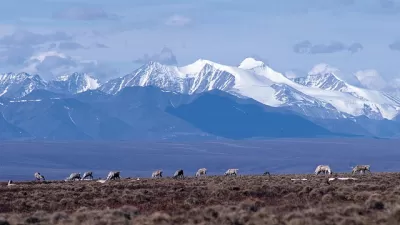Alaska Republican Senator Lisa Murkowski believes that politicians of both parties will support her five energy objectives: Make it abundant, affordable, clean, diverse and secure. Will it provide a 'conversation starter' to frame federal policy?
On Feb. 04, Murkowski held a press conference (covered by The Hill's Ben German for E2 Wire - the Energy and Environment Blog) where she unveiled her 116-page energy 'blueprint', "Energy 20/20: A Vision For America's Energy Future" (PDF). The blueprint was also the basis for her Republican weekly address on Feb. 09, covered by The Hill's Briefing Room blogger, Justin Sink.
“Energy is not a necessary evil. Energy is good. And that’s why it is in our national interest to make energy abundant, affordable, clean, diverse, and secure," Murkowski says in her address. "I believe that there’s a consensus around these five objectives, and our challenge now is to align federal policy with them."
Her "Energy is good" statement is also the first sub-heading in the plan (on page 3). It may very well have arisen from her "Superbowl moment" - the 30 minutes of blackout that had a major impact on the senator as she noted the day after the game on Feb. 04.
“I think it raises an awareness. Unfortunately for us, most of us take energy for granted. It’s just always there,” Murkowski told reporters on Monday morning, wrote German.
Murkowski acknowledged climate change in her Saturday address - noteworthy in that some of her Republican Senate colleagues still dismiss it.
"(The ideas in my blueprint) would help us minimize the impacts of energy development and reduce the emissions that are blamed for climate change,” Murkowski said.
Murkowski mentioned renewable energy and energy efficiency. "We can help make renewable energy more competitive, build on our efficiency gains...", she said. The table of contents of the blueprint (PDF) does include sub-sections on renewable resources and a section on "consuming less".
That said, the address appeared to stress a supply-oriented approach tilted toward fossil fuels. Controversies would appear inevitable with the role of regulations enacted by the Environmental Protection Agency to reduce carbon emissions and in other environmental issues.
In the plan, Murkowski calls for an end to regulations that Republicans believe will constrain the growth of coal-fired power plants, along with the immediate approval of the Keystone XL pipeline and the opening of the Arctic National Wildlife Refuge to drilling. Other components include expediting liquefied natural-gas exports, promoting the use of small modular nuclear reactors, and creating a new quasi-federal agency for nuclear waste management.
Sink writes how the plan will likely conflict with the president's energy and climate goals when it comes to the role of regulations.
President Obama has also called for a renewed focus on energy, devoting a significant part of his second inaugural address to a pledge to address climate change and environmentally friendly energy production.
The White House has said part of that effort will include new regulations from the Environmental Protection Agency aimed at reducing emissions from coal-burning power plants, along with ordering federal agencies — including the Pentagon — to reduce energy use.
However, give Murkowski credit for recognizing that many parts of her plan are controversial.
"It’s fair to say that not every member of Congress will support every proposal in my blueprint," Murkowski said. "And that’s why I describe it as a conversation starter. It’s intended to provoke a new and a better discussion about energy, to recognize how bright our future can be, and to provide a prudent alternative to the heavy-handed approaches coming from the Administration and the EPA."
FULL STORY: Sen. Murkowski: 'Energy is good'

Study: Maui’s Plan to Convert Vacation Rentals to Long-Term Housing Could Cause Nearly $1 Billion Economic Loss
The plan would reduce visitor accommodation by 25,% resulting in 1,900 jobs lost.

North Texas Transit Leaders Tout Benefits of TOD for Growing Region
At a summit focused on transit-oriented development, policymakers discussed how North Texas’ expanded light rail system can serve as a tool for economic growth.

Why Should We Subsidize Public Transportation?
Many public transit agencies face financial stress due to rising costs, declining fare revenue, and declining subsidies. Transit advocates must provide a strong business case for increasing public transit funding.

How to Make US Trains Faster
Changes to boarding platforms and a switch to electric trains could improve U.S. passenger rail service without the added cost of high-speed rail.

Columbia’s Revitalized ‘Loop’ Is a Hub for Local Entrepreneurs
A focus on small businesses is helping a commercial corridor in Columbia, Missouri thrive.

Invasive Insect Threatens Minnesota’s Ash Forests
The Emerald Ash Borer is a rapidly spreading invasive pest threatening Minnesota’s ash trees, and homeowners are encouraged to plant diverse replacement species, avoid moving ash firewood, and monitor for signs of infestation.
Urban Design for Planners 1: Software Tools
This six-course series explores essential urban design concepts using open source software and equips planners with the tools they need to participate fully in the urban design process.
Planning for Universal Design
Learn the tools for implementing Universal Design in planning regulations.
Ascent Environmental
Borough of Carlisle
Institute for Housing and Urban Development Studies (IHS)
City of Grandview
Harvard GSD Executive Education
Toledo-Lucas County Plan Commissions
Salt Lake City
NYU Wagner Graduate School of Public Service



























